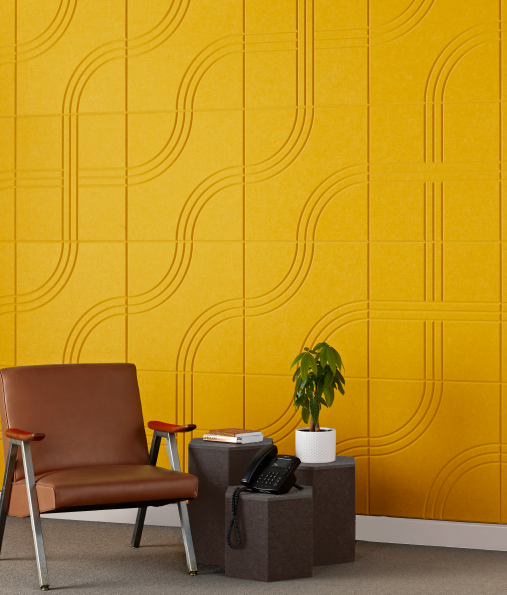The “return to office” is the challenge all designers are facing. How we work has evolved, and shows all signs of continuing to change. Some of us are returning to spaces that no longer serve our work styles while others are building spaces for team experiences that haven’t happened yet. How do you design for your clients now and as they continue to adapt into the future of work?
This was the focus of our conversation when we recently welcomed four talented designers to celebrate our latest launch, the Space Makers collection. They talked about their approaches to the ever-evolving post-pandemic hybrid workspace. Moderated by award-winning designer Michael DiTullo, panelists Heather Kampa (Principal & Designer, HGA Architects), Jordan Evans (Associate, Studios Architecture), and Maura Kessler (Interior Designer, CannonDesign) spoke from their design experiences to share how they’re collaborating with their clients and where they focus for the best results.

The conversation was packed with insightful approaches and thoughtful advice to help deliver unique, impactful spaces that work for clients now and as they continue to find their footing in their return to the office. Check out our top 5 takeaways from the event, below:

Image Source: EchoTile Sync Pangea Pattern in 108 Yellow, 193 Rouge, 325 Viridian Green, 365 Navy, 447 Slate, and 487 Blush.
1. Discover what brings your client’s team together at work.
Discuss their goals and what environments would be conducive to achieving them. Think about designing a space that maximizes the return on their investment through team health and growth resulting in an elevated work output.
2. Help foster the culture the client strives to embody.
Our work environments are a physical representation of our organizational values. Put employees first through the physical space by emphasizing what’s important. The office becomes an opportunity to create a healthy, inviting place that is used for collaboration, to foster mentorship, and to provide unique resources for the team.
It’s less about having that 5 feet for yourself to work on - you can do that at home - so what are the draws that are going to bring you into the new workspace?
- Jordan Evans
3. Empower your clients to do their best work by providing spatial autonomy.
No matter where it is, our goal as designers is to create spaces where our clients are successful. Give occupants the control over their environment to easily adapt the space to power their productivity.
The flexibility adds for more modularity and ownership because if you’re in the space and you decide, ‘I want to use this, but I need it over here next to the collaboration and whiteboard,’ then you have that ability to adjust as you go. And that again provides control to the user, which is the way we get people back into the office and collaborating with each other in person by providing them environments that they feel the most comfortable in and they can control.
- Heather Kampa

Image Source: EchoTile Sync Rice Paper Pattern in 325 Viridian Green, 365 Navy, 447 Slate, and 487 Blush.
4. Consider a holistic approach to creating sound spaces early on.
We know acoustics are more important than ever as we consider the health and wellness of our clients as well as their ideal space to perform the work they’ve come to do. Consider all surfaces and materials (walls, ceilings, furniture, etc.) to create an acoustically balanced environment that works for the intentions of the space.
Where and how can we put acoustic treatments throughout the space to make for a really sound environment? How do you integrate it to create an environment that is conducive to speaking and meetings?
- Heather Kampa
We’re seeing a lot more lounge spaces and breakout space, and I think those are areas where there aren’t necessarily going to be physical separating walls or devices, so we’re going to see more mental separations by using sound absorption materials.
- Maura Kessler
5. Build in a flexible workspace contingency plan.
As the new workplace is still maturing, we can use current research to inform our decisions while planning for continual evolution. As we work together to learn what success looks like for each unique organization, we can keep in mind the possibilities of our rapidly changing world to create adaptable spaces that grow with your client.
Office spaces are not just about the work being done, but the mission that the team is on and the culture that helps them thrive. The workplace is no longer a physical-first space, but rather a phygital space, as our friends at ThinkLab would say, with an emphasis on the digital. More than ever, teams work remotely across cities, states, countries, and timezones in addition to being physically present in the office. Developing spaces for these hybrid teams to thrive will become paramount to successful office spaces in the future.
Thank you again to our panelists, their thoughtful work, and their wonderful firms for sharing them with us.
View the full webinar below for additional insights:
Schedule a session with a Kirei design expert.
Most rooms sound terrible and most people don’t know what to do about it. Kirei provides great-looking architectural design elements that are easy to understand, specify and install, are made from recycled content, and improve the acoustics and functionality of any room. Browse our acoustic solutions and connect with a rep today.




